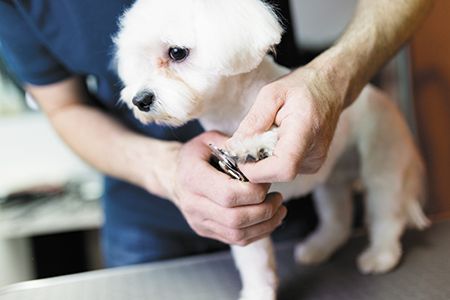Nix nail trim negativity
Scratch back at nail trim anxiety with these tips to reduce your veterinary patients fears.

Shutterstock.com
Editor's note: This is the second in a series of stress-reducing tips that include strategies for pet owners to try at home before the pet reaches your clinic. Keep an eye on dvm360.com/InClinicAtHome for more topics like cat carrier training, exam table woes and handling.
Oh, that dreaded nail trim. The very words have the power to strike fear in the stoutest hearted vet professional. But kitty and puppy pedicures don't need to be wrestling matches, filled with squirming, struggling and flailing-or, worse yet, scratching, growling or biting. Instead, teach your clients to practice these strategies at home to help reduce fear, anxiety and stress in their pets before they visit your practice for a nail trim.
The veterinary team's part:
> Don't force your way through fear. Instead, consider measures that will help the dog or cat to feel more comfortable with the handling for the nail trim.
> Keep perspective. A nail trim is rarely an emergency situation. Instead, for some cats and dogs, it's better to add in calming measures that will allow you to perform the nail trim without causing emotional trauma to the pet.
> Know when to medicate. In some cases, pharmaceutical intervention or sedation may be required to complete the nail trim. But, more than medication, it's important to prepare the cat or dog with handling exercises that condition a calmer, less stressed response before the visit.

Helping pets feel comfortable with a tail trim is key. | Shutterstock.com
The pet owner's part:
> Practice “Victory Visits.” These visits are structured lessons led by a veterinary team member that help the pet and owner with conditioning exercises to keep the animal calm during care in the hospital and home.
> Start at a place of comfort rather than immediately handling the nails. Teach the client to begin handling up higher, on the animal's shoulder for instance, rather than reaching for the paw. This allows the pet to start at a place of comfort that can eventually build into the nail trim. Pet owners can learn to slide their hands down the dog or cat's shoulder and transition to the paws, all the while pairing treats with handling.
> Combine the handling with allowing the animal to investigate nail trimmers. Teach the pet owner to present the trimmer in a way that keeps the animal calm. For example they can place the trimmer on the ground with treats dropped like snowfall on and around it, or hold the trimmer in their hand while presenting it to the animal with treats, ready to reward the pet for any look, sniff or touch of the clippers. The client can use a word like "good" or "treat" to teach the pet that their interest in the item is paired with rewards. Eventually, the pet owner can add in touching the pet's nails with items, like the backside of the clippers, or even a more neutral item, like a pen that gently taps each nail.
> Note the noise. Animals are also sensitive to sounds, and they can become fearful of the nail trim noise itself. You can reduce this trepidation by mimicking the nail trim sound and associating it with positive experiences.
You can mimic the sound by clipping uncooked pasta or carrots or even encouraging the pet owner to clip their own nails in the pet's presence. (Some animals will sensitize to the sound so much that even hearing their owner trim their own nails can be scary.) With each clip, pet owners should gently toss or roll a treat to the dog or cat. Start further away from the animal with the clipping noises before moving the mock clipping noise closer to the pet's nails.
> Start slow. Most important, before moving into doing the full cut, teach clients to create the right setup for a non-stressful experience. Whether the trim takes place at home or in the hospital, start with just one nail. Make sure pet owners know how to trim without clipping the nail too short or holding the animal in an uncomfortable position. Instead, teach the pet owner to let the animal relax comfortably.
> Proceed with caution. To transition the handling into the veterinary hospital, introduce the animal to each element of handling before a full trim, similar to the process at home-aiming to do these during Victory Visits or scheduled nail trims, with other calming measures like medication as needed and directed by the overseeing veterinarian. Deploy tasty treat distractions during handling and trims to minimize the animal's focus on the negatives and shift their focus towards the positives paired with the care experience.
Teach pet owners about the need to protect the pet's emotional experience during all care, including when the pet receives care at other places, such as the groomer. Remind the pet owner that every experience is a learning experience for the animal, and just one traumatic or scary experience can hinder your efforts.
Consider keeping a list of preferred providers who use Fear-Free-friendly, emotionally protective strategies for their grooming care. Offer clients follow-up training resources, such as having a list of certified, positive-reinforcement trainers or Fear Free animal trainers who can help pet owners help their pets.
When pets say, “Paws off my claws,” you need a better solution than manhandling them into submission. When you and your clients practice these strategies, you prepare pets for more positive pet care.
Mikkel Becker, CBCC-KA, CPDT-KA, CDBC, CTC, KPA Graduate, BA Communications, is the resident trainer for vetstreet.com and works in conjunction with veterinarians and veterinary behaviorists to address behavior issues in dogs and cats. Her four-legged best friend is Willy the pug, a certified therapy dog through the Delta Society.